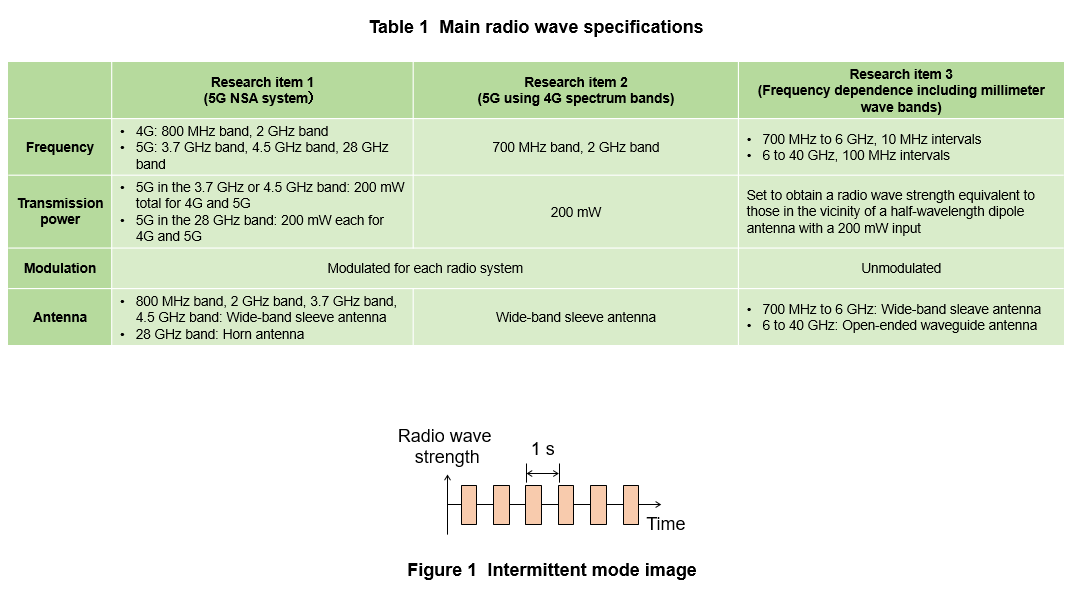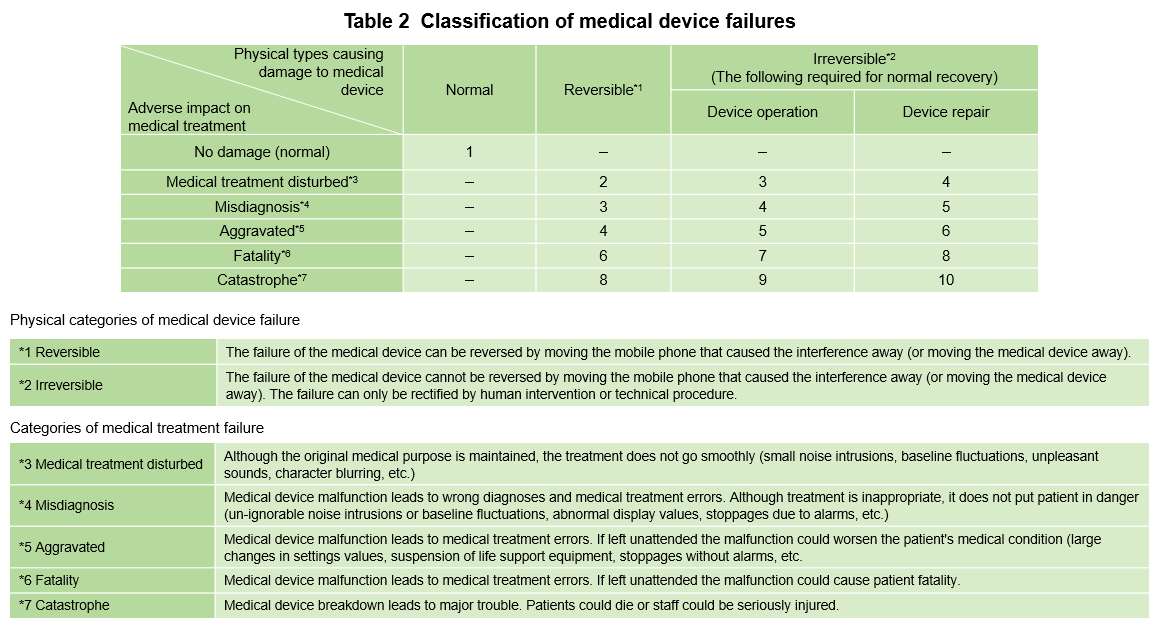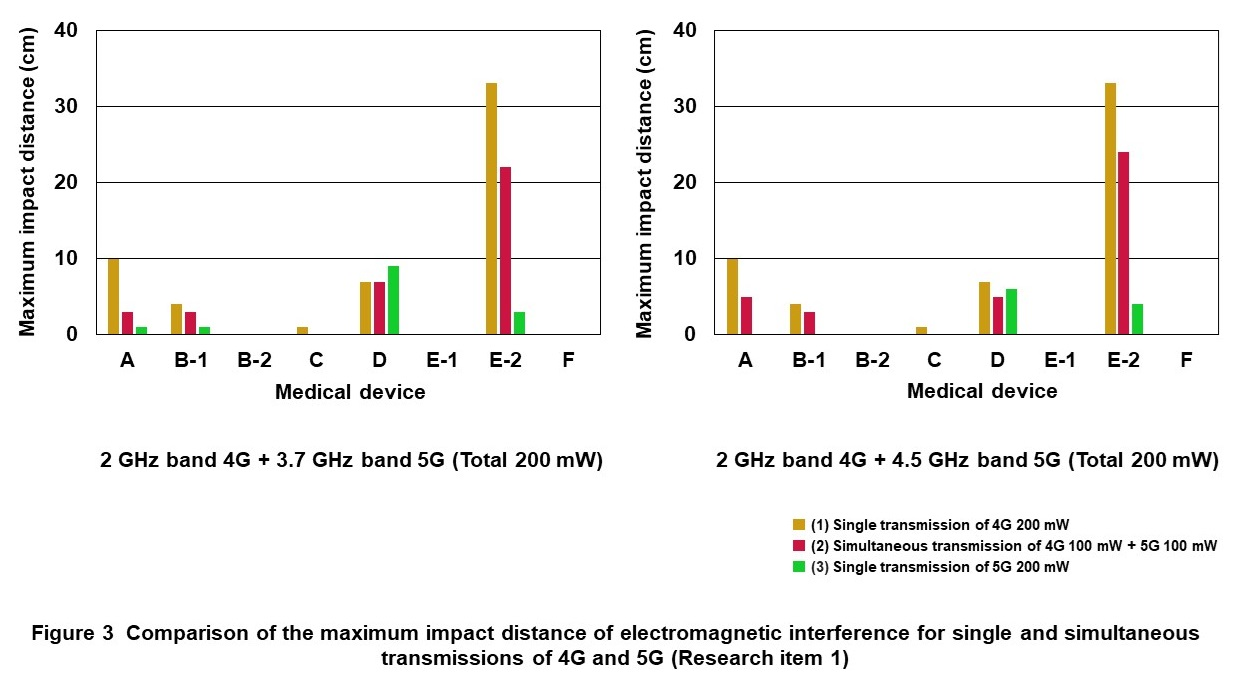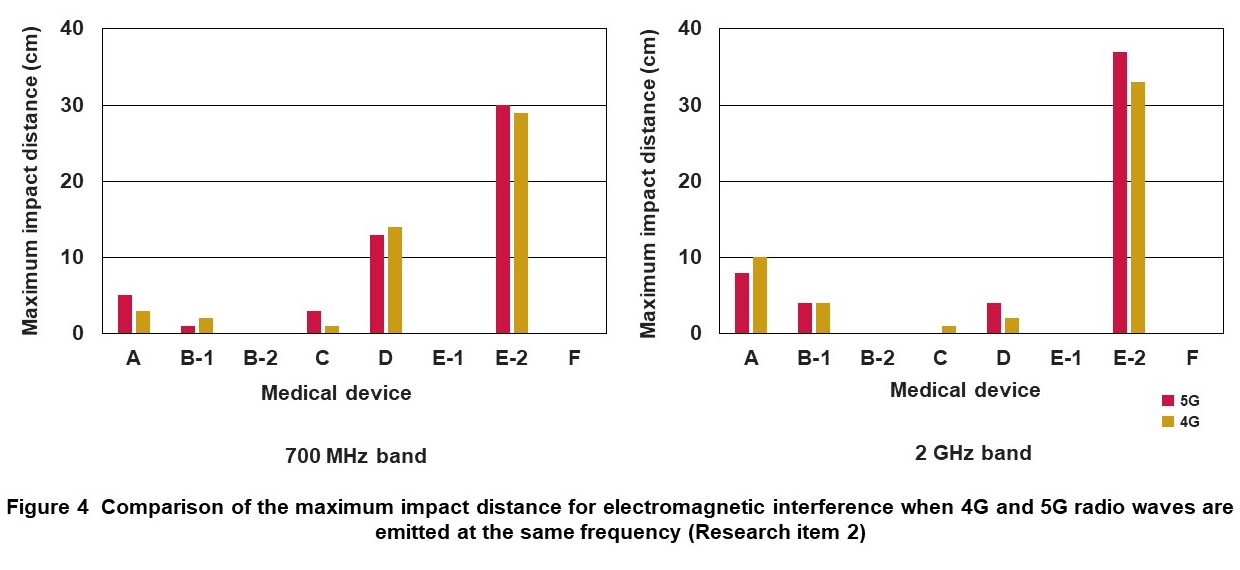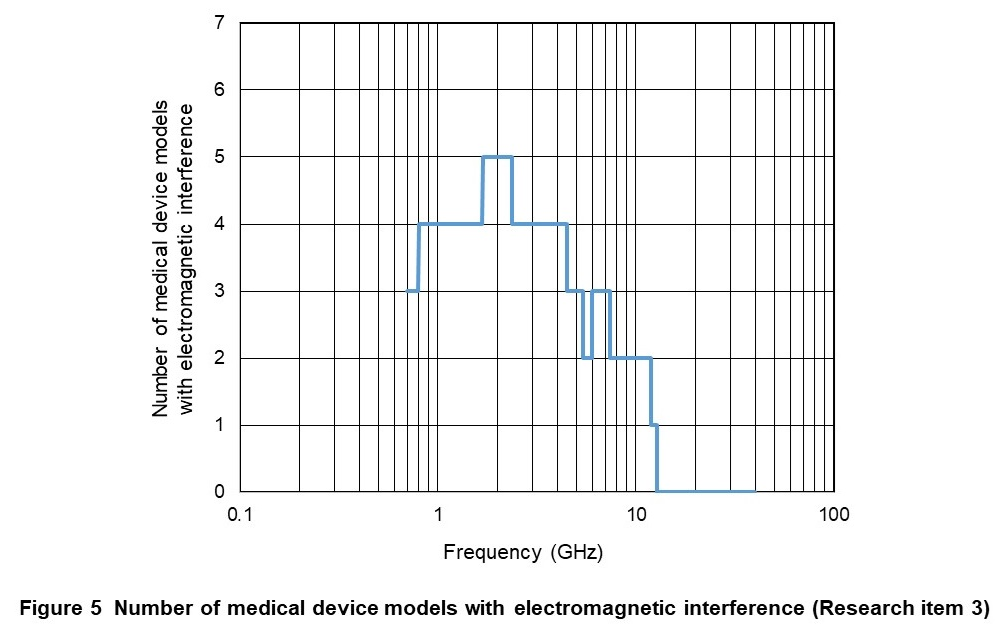Research of Electromagnetic Interference with Medical Devices in Hospitals for Mobile Phone and Smartphone Use
5G Healthcare Safety and Security
Takahiro Iyama, Yoshitoshi Tochikura, Junji Higashiyama and Yasunori Suzuki
6G Network Innovation Department
Ryota Ishioka
Spectrum Planning Office
Abstract
NTT DOCOMO continuously researches electromagnetic interference with medical devices caused by radio waves emitted from mobile phones and smartphones so that these radio communication devices can be further utilized in hospitals. In this study, we conducted new research on simultaneous 4G/5G transmission and 5G using 4G spectrum bands in consideration of current 5G operations, as well as research on frequency dependence with the view to future frequency utilization in mobile communication systems. This study was conducted jointly with Kanazawa University (Professor Keisuke Nagase, Department of Corporate Planning, Kanazawa University Hospital).
01. Introduction
-
Radio waves emitted from mobile phones and smartphones could ...
Open

Radio waves emitted from mobile phones and smartphones could cause electromagnetic interference with medical devices in close proximity. NTT DOCOMO continuously researches the impact of such electromagnetic interference. Among these, the results of research using radio waves emitted from mobile phones and smartphones equipped with 3rd and 4th Generation mobile communication systems (3G/4G), and Wireless Local Area Networks (WLANs), and basic research using radio waves in the candidate frequency bands of 5th Generation mobile communication systems (5G) have been previously reported in this journal [1]. These results have contributed to the formulation of the Electromagnetic Compatibility Conference Japan*1 guidelines [2] and guidance [3] for the safe and secure use of radio waves in hospitals, and have provided an engineering basis to enable the use of mobile phones and smartphones in hospitals.
Meanwhile, 5G, which began commercial services in March 2020 in Japan, has features such as high speed, large capacity, high reliability, low latency, and simultaneous connection of multiple terminals, and is expected to be further utilized for telemedicine and remote surgery, etc. in hospitals and medical workplaces [4]. From the viewpoint of safety and security, it is essential to clarify the conditions of electromagnetic interference that 5G radio waves may cause to medical devices, and the requirements for the resolution of electromagnetic interference. It is also important to understand the basic frequency dependence*2 of such electromagnetic interference in consideration of the future use of frequencies in mobile communication systems. For these reasons, we conducted research on electromagnetic interference with medical devices caused by such radio waves, assuming the current 5G operation system and future use of millimeter waves*3. The following three items were specifically researched:
- Research item 1: Electromagnetic interference with a 5G Non-Standalone (NSA) system*4
- Research item 2: Electromagnetic interference with 5G using 4G spectrum bands
- Research item 3: Frequency dependence of electromagnetic interference including millimeter wave bands
This article provides an overview of these research and their results. This research was conducted jointly with Kanazawa University (Professor Keisuke Nagase, Department of Corporate Planning, Kanazawa University Hospital). The operational settings of the various medical devices, determination of electromagnetic interference, and assessment of the degree of interference were performed by clinical engineers in charge of medical device operation, maintenance, and inspection at the hospital.
- Electromagnetic Compatibility Conference Japan: A joint industry-academic-government association concerned with issues such as electromagnetic interference.
- Frequency dependence: Refers to changes in physical quantities or responses of circuits or antennas depend on the frequency.
- Millimeter waves: Radio signals in the frequency band from 30 GHz to 300 GHz as well as the 28 GHz band used for 5G, all of which are customarily called “millimeter waves.”
- 5G NSA system: A 5G operation system in which, when using 5G radio technology New Radio (NR), control signals are transmitted over 4G, i.e., LTE networks, and NR and LTE are used in cooperative operation for user data transmission only.
-
In this research, radio wave specifications such as radio frequency, ...
Open

In this research, radio wave specifications such as radio frequency, modulation schemes, and antennas for transmitting radio waves onto medical devices are set according to the items to be researched. The procedures are the same for all research items and are almost the same as those used in past research. Details are shown below.
2.1 Main Specifications of Radio Waves
We configured a system consisting of a signal generator to generate the desired signal, an amplifier*5 to adjust the transmission power, and an antenna that emits the signal as a radio wave. Table 1 shows the main specifications of the radio waves for each research item.
For research items 1 and 2, signals with bandwidths and modulation schemes that match actual operational conditions were used on channels that are roughly at the center of the frequency bands allocated to NTT DOCOMO. Transmission power was set with reference to the technical standards for each radio system. For antennas, wide-band sleeve antennas*6 and horn antennas*7 were used according to the frequency.
For research item 3, an unmodulated signal was used, given that this was the initial study. The transmission power was set so that the radio wave strength would be equivalent to the vicinity of the antenna with 200 mW input to the half-wave dipole antenna*8 used in previous research. For antennas, a wide-band sleeve antenna and an open-ended waveguide antenna*9 were used according to the frequency.
Past research showed that medical equipment is susceptible to electromagnetic interference from radio waves in “intermittent mode,” meaning the waves are repeatedly turned ON/OFF approximately 60 times per minute. Therefore, we used the signals with the waveform shown in Figure 1, which are the modulated and unmodulated signals described above plus the “intermittent mode” time control.
2.2 Test Location
Since it is necessary to prevent leakage of radio waves generated by the signal generator to the outside, tests were conducted in a shielded tent set up in a room in the Kanazawa University Hospital.
2.3 Test Procedure
The stronger the radio wave emitted to the medical device, the more likely electromagnetic interference is to occur. For the basic test, we scanned all surfaces of the medical device while changing the direction of the antenna for each surface under the following conditions (Figure 2 (a)).
- Intermittent mode
- Set transmission power
- Antenna close to medical device
When sensors and cables were connected to medical devices, they were also tested. When electromagnetic interference occurred, as an additional test, we gradually moved the antenna away from the medical device in intermittent mode and at the set transmission power to determine the distance at which the electromagnetic interference disappears (hereinafter referred to as “maximum impact distance”) (Fig. 2 (b)). Photo 1 shows a scene of the test using a wide-band sleeve antenna and an open-ended waveguide antenna.
2.4 Classification of Electromagnetic Interference
The category classification described in a report published by the Ministry of Internal Affairs and Communications in 2002 [5] was used as an indicator of the degree of impact on actual medical treatments when electromagnetic interference is confirmed. Categories are determined according to Table 2, based on the physical damage to medical device and adverse impact on medical treatments. These classifications were determined by healthcare professionals.
2.5 Medical Devices Tested
Focusing on medical devices that caused electromagnetic interference in past tests, we selected medical devices to test such as external pacemakers and electrocardiographs. Depending on the research items, six or seven types of medical devices were included in the test.
- Amplifier: A circuit that amplifies a signal.
- Wide-band sleave antenna: An antenna that can transmit and receive radio waves efficiently over a wide frequency range. Used for electromagnetic interference evaluation of in-vehicle equipment, etc.
- Horn antenna: A type of antenna with a pyramid or cone shape, which emits a signal that is strong in a particular direction.
- Half-wave dipole antenna: A very basic antenna which has two 1/4-wavelength elements arranged in a straight line at the end of the cable (the feed point).
- Open-ended waveguide antenna: An antenna made by using an open cross-section of a waveguide, which is a transmission line for microwaves and millimeter waves.
-
Results for each research item are shown below. For all tests, ...
Open

Results for each research item are shown below. For all tests, the maximum number of categories of electromagnetic interference was four.
3.1 Electromagnetic Interference in a 5G NSA System
This test was conducted by irradiating various medical devices with 4G and 5G radio waves simultaneously emitted from antennas at different frequencies and modulations [6]. As an example of the results of the test, Figure 3 shows the maximum impact distance when 4G radio waves in the 2 GHz band and 5G radio waves in the 3.7 GHz or 4.5 GHz band are transmitted simultaneously. In this case, the total transmission power of 4G and 5G radio waves is specified as less than 200 mW, so we compared the maximum impact distance for three patterns: (1) 4G 200 mW only, (2) 4G 100 mW + 5G 100 mW, and (3) 5G 200 mW only. It was found that the maximum impact distance for pattern (2), in which 4G and 5G radio waves were transmitted simultaneously, was no greater than either pattern (1) or (3), therefore we found that the maximum impact distance could be sufficiently obtained from patterns (1) and (3), in which 4G or 5G radio wave were transmitted independently at 200 mW. The same results were obtained for the maximum impact distance when 4G modulation waves in the 800 MHz band were combined with 5G modulation waves in the 3.7 GHz or 4.5 GHz band.
In addition, with the total transmission power of 4G and 5G radio waves less than 200 mW each, the impact of the combination of 4G modulation waves in the 2 GHz or 800 MHz band and 5G modulation waves in the 28 GHz band was compared for three patterns: (1) 4G 200 mW only, (2) 4G 200 mW + 5G 200 mW, (3) 5G 200 mW only. The maximum impact distance was compared for these three patterns, and as a result, the maximum impact distances in patterns (1) and (2) were almost identical, and in pattern (3), no impact was observed.
The above results suggest that the impacts on medical devices by simultaneous 4G and 5G transmission can be estimated from the results of a single transmission only.
3.2 Electromagnetic Interference in 5G Using 4G Spectrum Bands
Radio waves in the 4G commercial frequency bands were emitted from the antennas onto various medical devices. In these cases, only the modulation was switched between 4G and 5G while keeping the transmission power the same [7]. As an example of the test results, Figure 4 shows the maximum impact distance in the 700 MHz and 2 GHz bands. Different modulation did not cause a significant difference in the impact on medical devices or the maximum impact distance. The results of this test suggest that electromagnetic interference with medical devices caused by radio waves emitted from mobile phones and smartphones is likely to be less dependent on modulation. Therefore, to our knowledge, it is possible to refer to the results of tests for 4G radio waves to predict electromagnetic interference with medical devices caused by 5G radio waves using 4G spectrum bands.
3.3 Frequency Dependence of Electromagnetic Interference Including Millimeter Wave Bands
Radio waves were emitted from an antenna onto various medical devices while continuously sweeping frequencies from 700 MHz to 40 GHz [8]. As an example of the test results, Figure 5 shows the number of medical device models in which electromagnetic interference occurred. The number of these medical devices increased mostly around 2 GHz, and then tended to decrease as the frequency increased. Above roughly 13 GHz, no impacts of electromagnetic interference were found in any medical devices tested.
Since this test was conducted mainly on medical devices that were affected by electromagnetic interference in past research, the results suggest the possibility of electromagnetic interference with medical devices may be low at frequencies above 13 GHz.
-
This article has described the results of research of electromagnetic interference ...
Open

This article has described the results of research of electromagnetic interference with medical devices caused by radio waves emitted from mobile phones and smartphones, in which current 5G operation and future millimeter wave applications are especially considered. The results of this research will contribute to safer and more secure use of 5G and future mobile communication systems in hospitals and medical workplaces. We also plan to continue research electromagnetic interference with medical devices in accordance with future radio wave usage.
-
REFERENCES
Open

- [1] T. Iyama et al.: “Investigative Research into Electromagnetic Interference with Medial Equipment from Radio Waves Emitted by Mobile Telephones and Smartphones,” NTT DOCOMO Technical Journal, Vol. 20, No. 2, pp. 60–67, Nov. 2018.
- [2] Electromagnetic Compatibility Conference Japan: “Guidelines for Use of Mobile Phones and Other Devices in hospitals—For Secure, Safe Use of Wireless Communication Devices in Hospitals—,” Aug. 2014.
 https://www.emcc-info.net/medical_emc/pubcom2/2608_5.pdf
https://www.emcc-info.net/medical_emc/pubcom2/2608_5.pdf - [3] Electromagnetic Compatibility Conference Japan: “Guide for Safe and Secure Use of Radio Waves in Hospitals (Revised Edition),” Jul. 2021 (in Japanese).
 https://www.emcc-info.net/medical_emc/202107/medical_guide_rvsn.pdf
https://www.emcc-info.net/medical_emc/202107/medical_guide_rvsn.pdf - [4] NTT DOCOMO Press Release: “First demonstration of remote robotic operation with a combination of a domestic commercial surgical robot and a commercial 5G network in the world,” Apr. 2021 (in Japanese).
 https://www.docomo.ne.jp/binary/pdf/corporate/technology/rd/topics/2021/topics_210416_00.pdf (PDF format:611KB)
https://www.docomo.ne.jp/binary/pdf/corporate/technology/rd/topics/2021/topics_210416_00.pdf (PDF format:611KB) - [5] Ministry of Internal Affairs and Communications: “Study Report on the Effect of Radio Waves on Medical Devices,” Mar. 2002 (in Japanese).
- [6] Y. Tochikura, T. Iyama, J. Higashiyama, Y. Suzuki and K. Nagase: “Evaluation of Electromagnetic Interference to Medical Electrical Equipment by Simultaneous Emission of 4G (LTE) and 5G (NR) Signals,” 2022 IEICE Society Conference, B-19-12, Sep. 2022 (in Japanese).
- [7] Y. Tochikura, T. Iyama, J. Higashiyama, Y. Suzuki and K. Nagase: “Comparison of Electromagnetic Interference to Medical Electrical Equipment at the Same Frequency: 5G (NR) Radio Waves vs 4G (LTE) Radio Waves,” 2023 IEICE Society Conference, B-19-7, Sep. 2023 (in Japanese).
- [8] R. Ishioka, J. Higashiyama, T. Onishi and K. Nagase: “Frequency Dependence of Electromagnetic Interference with Medical Devices due to Radio Waves of Mobile Phones,” 2019 IEICE General Conference, B-20-1, Mar. 2019 (in Japanese).




